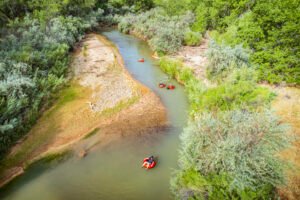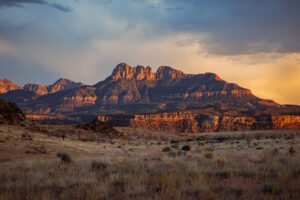Zion National Park is a stunning destination that draws visitors from all over the world. Known for its towering red rock cliffs, verdant valleys, and the meandering Virgin River, Zion is a place of breathtaking beauty and adventure. While the park is a year-round destination, summer is particularly popular. However, with the summer season comes intense heat, which can impact your visit if you’re not prepared. In this blog post, we’ll discuss what to expect when visiting Zion National Park during the peak of summer, considerations for visitors of all ages, and the top three ways to cool off from the heat.
What to Expect When Visiting Zion in the Summer
High Temperatures
Summer in Zion National Park can be scorching. Daytime temperatures often exceed 100°F (38°C), especially in July and August. The dry desert heat can be intense, making it crucial for visitors to plan their activities accordingly. Early mornings and late afternoons are the best times for hiking and exploring, as the temperatures are slightly cooler. Midday should be reserved for less strenuous activities or relaxation in shaded areas.
Crowded Conditions
The summer months are peak tourist season in Zion National Park. Expect crowded trails, busy shuttle buses, and limited parking. Popular hikes like Angels Landing and The Narrows can be particularly congested. To avoid the crowds, consider starting your day early or exploring some of the park’s lesser-known trails and areas.
Longer Days
One advantage of visiting Zion in the summer is the long daylight hours. The sun rises early and sets late, giving you plenty of time to explore and enjoy the park. This extended daylight is perfect for fitting in multiple activities in a single day, from hiking and biking to tubing on the Virgin River.
Considerations for Various Ages
Families with Young Children
Visiting Zion with young children can be a rewarding experience, but it requires careful planning. The heat can be challenging for little ones, so it’s essential to keep them hydrated and protected from the sun. Make sure to bring plenty of water, sunscreen, hats, and lightweight, breathable clothing. Consider shorter, kid-friendly hikes like the Riverside Walk or the Lower Emerald Pools Trail. Midday breaks in shaded areas or at your accommodation can help keep children comfortable.
Teenagers and Active Adults
Teenagers and active adults will find plenty to do in Zion during the summer. From challenging hikes like Angels Landing to rock climbing and canyoneering, the park offers a wide range of adventurous activities. However, the heat can be a concern, so it’s important to stay hydrated and take breaks in the shade. Wearing moisture-wicking clothing and a hat can also help keep you cool.
Seniors
For older visitors, the summer heat in Zion can be particularly taxing. Choosing activities that are less strenuous and offer opportunities for shade is essential. The Zion Canyon Scenic Drive provides stunning views without the need for extensive walking. The Pa’rus Trail is a relatively flat, paved path that is accessible and offers beautiful scenery. Additionally, taking the park shuttle to various viewpoints and enjoying the sights from the comfort of the bus can be a great way to experience Zion.
Top 3 Ways to Cool Off from the Heat
Tubing on the Virgin River
One of the best ways to beat the summer heat in Zion National Park is by tubing on the Virgin River. This relaxing activity allows you to float down the river while taking in the breathtaking scenery. The cool water provides a refreshing break from the high temperatures, and the gentle currents make it a family-friendly activity. Make sure to wear water shoes and bring plenty of sunscreen. Tubing companies provide the necessary equipment and often offer transportation back to your starting point.
Visiting the Emerald Pools
The Emerald Pools are a popular destination in Zion National Park, offering a series of pools and waterfalls that are perfect for cooling off. There are three different pools—Lower, Middle, and Upper Emerald Pools—each accessible by a network of trails. The Lower Emerald Pools Trail is the easiest and most family-friendly, while the Middle and Upper Pools require more effort but reward hikers with stunning views and cooler temperatures. Remember to bring plenty of water and wear sturdy shoes, as some sections of the trail can be slippery.
Exploring the Narrows
The Narrows is one of Zion’s most iconic hikes and a fantastic way to escape the summer heat. This hike takes you through the narrowest section of Zion Canyon, where the Virgin River has carved a deep, winding gorge. Most of the hike involves wading through the river, with towering canyon walls providing shade and cooler temperatures. The water levels can vary, so it’s important to check conditions before starting your hike. Wearing quick-drying clothing and renting water shoes and a walking stick from a local outfitter can make the experience more comfortable.
Additional Tips for Staying Cool
- Stay Hydrated: The dry heat in Zion can quickly lead to dehydration. Carry plenty of water and drink regularly, even if you don’t feel thirsty. Consider using a hydration pack for easy access to water during hikes.
- Wear Sun Protection: Use a broad-spectrum sunscreen with at least SPF 30, and reapply it every two hours. Wear a wide-brimmed hat, sunglasses, and lightweight, long-sleeved clothing to protect your skin from the sun.
- Take Breaks: Listen to your body and take regular breaks in the shade. Overexertion in the heat can lead to heat exhaustion or heat stroke, so it’s important to rest and cool down when needed.
- Plan Indoor Activities: Take advantage of the Visitor Center, Zion Human History Museum, and local shops and cafes during the hottest parts of the day. These indoor activities provide a break from the heat while allowing you to learn more about the park’s history and geology.
- Check Weather Conditions: Summer weather in Zion can be unpredictable, with occasional thunderstorms in the afternoon. Check the weather forecast before heading out and be prepared to adjust your plans if necessary. Avoid narrow canyons and river hikes during stormy weather due to the risk of flash floods.


